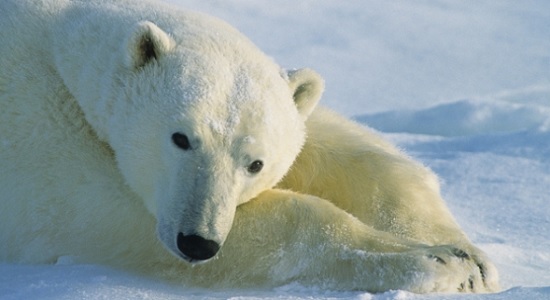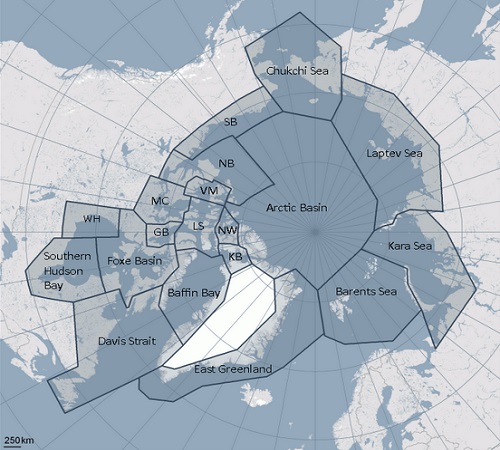Taxonomy
Kingdom |
Phylum |
Class |
Order |
Family |
Genus |
Species |
| Animalia | Chordata | Mammalia | Carnivora | Ursidae | Ursus | Ursus maritimus |
0

Polar bear in the Canadian Arctic. Source: Polar Bears International
0
Name
- Scientific name: Ursus maritimus
- Common name: White bear, ice bear, polar bear.
Distribution and Habitat
- The polar bear is distributed throughout the Arctic Circle and surrounding areas. Their range is limited by the extent of sea ice.
- Their range includes territories of 5 nations: Denmark, Norway, Russia, USA and Canada. These countries have signed the International Agreement on the Conservation of Polar Bears.
- Their preferred habitat includes pack ice that covers the water of the continental shelf and Arctic along the coast and archipelagos.
- Scientists have identified 19 populations living in four sea ice eco-regions.
- Seasonal ice eco-region is located at the southernmost range of the polar bear distribution. Here ice melts in the summer and bears wait on land until the fall when the sea freezes and they can start hunting again. This is the most vulnerable population at risk from global warming.
- In the Divergent ice eco-region sea ice forms along the shore but retreats during summer. These populations have to swim long distances to reach pack ice and food.
- Ice that forms in other parts of the Arctic flows towards and collects in the Polar basin convergent ice eco-region providing polar bears access to seals.
- Archipelago ice eco-region is located in the northernmost range high in the Arctic and Greenland. Ice does not melt in the summer providing hunting grounds for polar bears.

Polar bear population distribution map. Source: IUCN/SSC PBSG. SB-Southern Beaufort Sea. NB-Northern Beaufort Sea. VM-Viscount Melville Sound, MC-M’Clintock Channel. WH-Western Hudson Bay. GB-Gulf of Boothia. LS-Lancaster SOund. NW-Norwegian Bay. KB-Kane Basin.
Physical Features
- Males are twice as large as females.
- Their fur is generally white but their skin is black. Their fur can be yellowish in the summer due to oxidation and sometimes it may appear gray or brown depending on the season and light.
- Its fur consists of a layer of dense underfur and an outer layer of guard hairs which are actually transparent.
- They have 42 teeth.
- Polar bears have large and stocky bodies without the shoulder hump that characterizes the brown bear.
- They have broad paws with partial webbing serving as paddles when swimming. They have tufts of fur between their toes and footpads that serve as insulation.
- Their footpads are black and covered with bumps called papillae which provide traction when walking on ice.
- They have small ears and tail to help them conserve heat.
- Their bodies are covered by up to 4 inches or 10 cm of blubber that provides insulation against freezing temperatures.
- The polar bear is similar in size as the Kodiak bear, a subspecies of the brown bear.
Weight and Height
- The weight of adult males ranges from 661 to 1,764 lbs or 300 to 800 kg, while that of adult females from 330 to 661 lbs or 150 to 300 kg.
- The height of adult males ranges from 7ft 10in to 9ft 10in or 2.4 to 3 meters. Adult females are between 5ft 11in to 7ft 10in or 1.8 to 2 meters in length.
Behavior
- Polar bears are solitary animals except when breeding and when females are raising cubs. They congregate in areas where food is abundant.
- Some polar bears are residents meaning that they live in the same area all year round. When the ice melts they spend time on land where they use up their fat reserves until the sea freezes and they can hunt again.
- Others migrate long distances when ice melts. Some travel north as far as 620 miles or 1000 km and when the ice freezes they will travel south the same distance.
- They travel alone to find food. They stay near water and can swim as far as 60 miles with no rest and up to 6 miles/ hr.
- They use their sense of smell to hunt. They hunt their food from the edge of sea ice waiting for seals to surface from ice holes to breathe.
- Polar bears do not hibernate like black bears, only pregnant females quasi-hibernate. True hibernation requires a drop in heart rate and body temperature which pregnant females do not experience.
Diet
- The polar bear is an apex predator; they are at the top of the food chain.
- They are carnivore and opportunistic eaters. Most of their diet is based on seals such as ringed seals, bearded seals, harp seals and hooded seals. They will also consume walruses, sea birds and the carrion of dead animals.
- They will occasionally consume vegetation.
Reproduction
- Polar bears reach reproductive maturity between 5 and 6 years old.
- Breeding season is from March to June. Females reproduce every 2 to 4 years.
- Gestation lasts from 200 to 265 days which includes delayed implantation.
- Litter size is 1 to 4.
- Between November and December pregnant females will dig a den in the snow where they will give birth.
The young
- Cubs are called coys in their first year. They are born between November and January.
- They weight 1.32 lb or 600 grams when they are born.
- They feed exclusively their mother’s milk which is rich in fat until they are ready to leave the den in March or April
- Cub mortality is between 10 to 30%.
Life Expectancy
- In the wild the polar bear is expected to live from 25 to 30 years.
- In captivity its life expectancy range is from 35 to 40 years.
- In captivity the oldest recorded lifespan was a female at the Detroit Zoo who died at the age of 43.
Threats
- Polar bears have been hunted by native peoples for centuries. They hunt them for their meat, fur and medicinal uses.
- The loss of habitat due to reduced ice coverage is accelerated by global warming. Scientists predict that the southernmost range of their habitat will melt within 75 years.
- Low reproductive rate. Polar bears will reproduce only every 2 to 3 years and give birth to an average of 2 cubs.
- Stress from increase pollution, open shipping lanes, gas and oil exploration.
Conservation Status
- The IUCN Red List of Threatened Species lists the polar bear as a “vulnerable” species.
- The IUCN predicts a population decline of more than 30% within 45 years due to decline of quality and extend of their habitat.
- This species is protected by CITES Appendix II.
Related Species
 |
 |
 |
 |
| Bear, Andean or Spectacled |
Bear, Asiatic Black |
Bear, Black | Bear, Brown |
 |
 |
 |
 |
| Bear, Giant Panda | Bear, Polar | Bear, Sloth | Bear, Sun |
References and further research
Marine Biology Conservation Society – Polar bear, ursus maritimus
Smithsonian National Museum of Natural History – Ursus maritimus polar bear
IUCN Red List of Threatened Species – Ursus maritimus
University of Michigan Museum of Zoology – Ursus maritimus polar bear
Marine Species Identification Portal – Polar bear (Ursus maritimus)
IUCN/CCS Polar Bear Specialist Group
